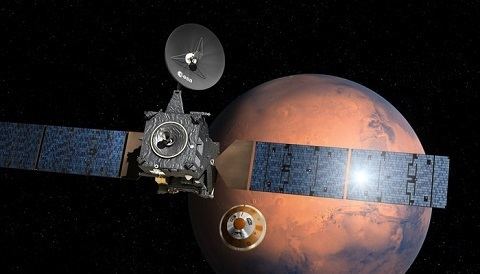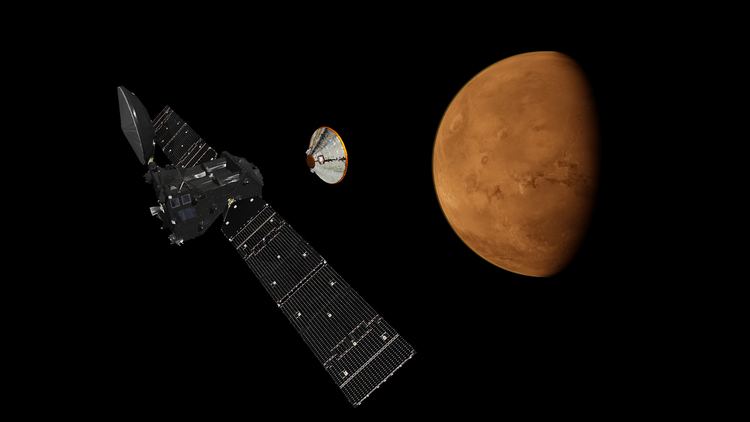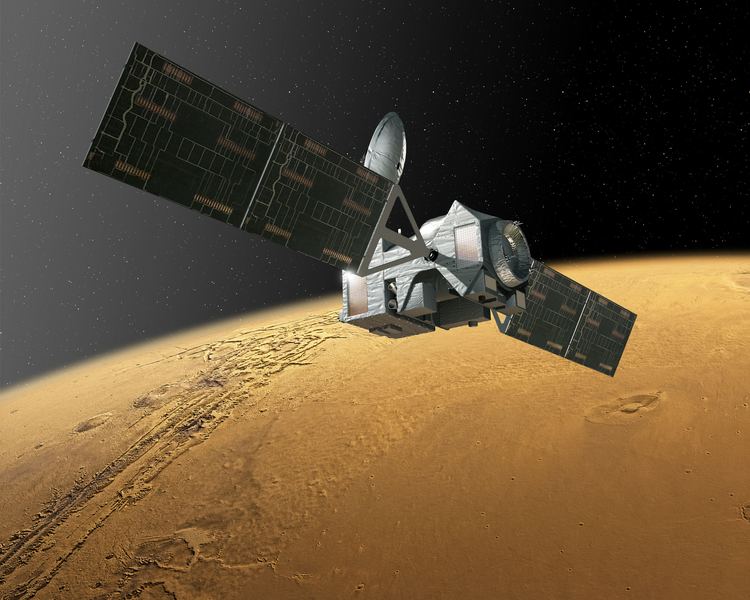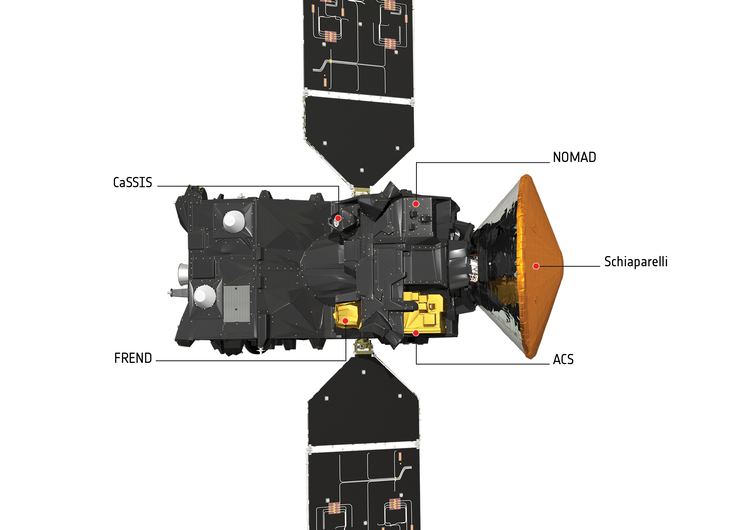Mission type Mars orbiter COSPAR ID 2016-017A Launch date 14 March 2016 | Operator ESA · Roscosmos SATCAT no. 41388 Manufacturer Thales Alenia Space | |
Mission duration Planned: 7 years
Elapsed: 11 months, 24 days Similar Schiaparelli EDM lander, Mars Express, Mars Reconnaissance Orbiter, Beagle 2, MAVEN | ||
Exomars trace gas orbiter tgo orbiter space flight simulator
The ExoMars Trace Gas Orbiter (TGO) is a collaborative project between the European Space Agency (ESA) and Roscosmos that sent an atmospheric research orbiter and the Schiaparelli demonstration lander to Mars in 2016 as part of the European-led ExoMars programme.
Contents
- Exomars trace gas orbiter tgo orbiter space flight simulator
- Ksp exomars trace gas orbiter schiaparelli lander
- History
- Origins
- Attempted collaboration with NASA
- Collaboration with Russia
- Launch
- Status
- Specifications
- Science
- Payload
- Relay telecommunications
- References

The Trace Gas Orbiter delivered the Schiaparelli lander and will start atmospheric mapping in 2017. A key goal is to gain a better understanding of methane (CH
4) and other trace gases present in the Martian atmosphere that could be evidence for possible biological activity. The programme will follow with the Surface Science Platform and the ExoMars rover in 2020, which will search for biomolecules and biosignatures; the TGO will operate as the communication link for the 2020 ExoMars rover and surface science platform and provide communication for other Mars surface probes with Earth. The lander's radio signal was lost during the descent through the Mars atmosphere and later the lander was confirmed to have crashed.

Ksp exomars trace gas orbiter schiaparelli lander
History

Investigations with space and Earth-based observatories have demonstrated the presence of a small amount of methane on the atmosphere of Mars that seems to vary with location and time. This may indicate the presence of microbial life on Mars, or a geochemical process such as volcanism or hydrothermal activity.

The challenge to discern the source of methane in the atmosphere of Mars prompted the independent planning by ESA and NASA of one orbiter each that would carry instruments in order to determine if its formation is of biological or geological origin, as well as its decomposition products such as formaldehyde and methanol.
Origins

ExoMars Trace Gas Orbiter was born out of the nexus of ESA's Aurora programme ExoMars flagship and NASA's 2013 and 2016 Mars Science Orbiter (MSO) concepts. It became a flexible collaborative proposal within NASA and ESA to send a new orbiter-carrier to Mars in 2016 as part of the European-led ExoMars mission. On the ExoMars side, ESA authorized about half a billion Euros in 2005 for a rover and mini-station; eventually this evolved into being delivered by an orbiter rather than a cruise stage.
Attempted collaboration with NASA

NASA's Mars Science Orbiter (MSO) was originally envisioned in 2008 as an all-NASA endeavour aiming for a late 2013 launch. NASA and ESA officials agreed to pool resources and technical expertise and collaborate to launch only one orbiter. The agreement, called the Mars Exploration Joint Initiative, was signed on July 2009 and proposed to use an Atlas rocket launcher instead of a Soyuz rocket, which significantly altered the technical and financial setting of the European ExoMars mission. Since the ExoMars rover was originally planned to be launched along with the TGO, a prospective agreement would require that the rover lose enough weight to fit aboard the Atlas launch vehicle with NASA's orbiter. Instead of reducing the rover's mass, it was nearly doubled when the mission was combined with other projects to a multi-spacecraft programme divided over two Atlas V launches: the ExoMars Trace Gas Orbiter (TGO) was merged into the project, carrying a meteorological lander planned for launch in 2016. The European orbiter would carry several instruments originally meant for NASA's MSO, so NASA scaled down the objectives and focused on atmospheric trace gases detection instruments for their incorporation in ESA's ExoMars Trace Gas Orbiter.
Under the FY2013 budget President Barack Obama released on 13 February 2012, NASA terminated its participation in ExoMars due to budgetary cuts in order to pay for the cost overruns of the James Webb Space Telescope. With NASA's funding for this project cancelled, most of ExoMars' plans had to be restructured.
Collaboration with Russia
On 15 March 2012, the ESA's ruling council announced it would press ahead with its ExoMars program in partnership with the Russian space agency Roscosmos, which planned to contribute two heavy-lift Proton launch vehicles and an additional entry, descent and landing system to the 2020 rover mission.
Under the collaboration proposal with Roscosmos, the ExoMars mission is split into two parts: the orbiter/lander mission in March 2016 that includes the TGO and a 2.4 m (7 ft 10 in) diameter stationary lander build by ESA named Schiaparelli; this will be followed by the ExoMars rover mission in 2020 —also to be launched with a Russian Proton rocket.
Launch
The Trace Gas Orbiter and descent module Schiaparelli completed testing and were integrated to a Proton rocket at the Baikonur Cosmodrome in Kazakhstan in mid-January 2016. The launch occurred at 09:31 UTC on 14 March 2016. Four rocket burns occurred in the following 10 hours before the descent module and orbiter were released. A signal from the spacecraft was received at 21:29 UTC that day, confirming that the launch was successful and the spacecraft were functioning properly.
Shortly after separation from the probes, a Brazilian ground telescope recorded small objects in the vicinity of the Briz-M upper booster stage, suggesting that the Briz-M stage exploded a few kilometres away, without damaging the orbiter or lander. Briefing reporters in Moscow, the head of Roscosmos denied any anomaly and made all launch data available for inspection.
Status
The Schiaparelli lander separated from the TGO orbiter on 16 October 2016, three days before it arrived on Mars, and entered the atmosphere at 21,000 km/h (13,000 mph; 5.8 km/s). The lander's radio signal was lost during the descent through the atmosphere, and as of 20 October 2016, the descent data are still being analysed.
The TGO was injected into Mars orbit on 19 October 2016 and it will undergo several months of aerobraking to adjust its speed and manoeuvre into a 400 km (250 mi) high circular orbit above the planet, with science activities scheduled to begin in late 2017.
Specifications
Science
The TGO separated from the ExoMars Schiaparelli demonstration lander and would have provided it with telecommunication relay for 8 Martian solar days (sols) after landing. Then the TGO will gradually aerobrake for seven months into a more circular orbit for science observations and will provide communications relay for the ExoMars rover to be launched in 2020, and will continue serving as a relay satellite for future landed missions until 2022.
The FREND instrument will map hydrogen levels to a maximum depth of 1 m (3 ft 3 in) beneath the Martian surface. Locations where hydrogen is found may indicate water-ice deposits, which could be useful for future crewed missions.
Particularly, the mission will characterise spatial, temporal variation, and localisation of sources for a broad list of atmospheric trace gases. If methane (CH
4) is found in the presence of propane (C
3H
8) or ethane (C
2H
6), that will be a strong indication that biological processes are involved. However, if methane is found in the presence of gases such as sulfur dioxide (SO
2), that would be an indication that the methane is a byproduct of geological processes.
The nature of the methane source requires measurements of a suite of trace gases in order to characterise potential biochemical and geochemical processes at work. The orbiter has very high sensitivity to (at least) the following molecules and their isotopomers: water (H
2O), hydroperoxyl (HO
2), nitrogen dioxide (NO
2), nitrous oxide (N
2O), methane (CH
4), acetylene (C
2H
2), ethylene (C
2H
4), ethane (C
2H
6), formaldehyde (H
2CO), hydrogen cyanide (HCN), hydrogen sulfide (H
2S), carbonyl sulfide (OCS), sulfur dioxide (SO
2), hydrogen chloride (HCl), carbon monoxide (CO) and ozone (O
3). Detection sensitivities are at levels of 100 parts per trillion, improved to 10 parts per trillion or better by averaging spectra which could be taken at several spectra per second.
4) with different photochemical lifetimes and correlations helps constrain model simulations and points to source/sink regions.
Payload
Like the Mars Reconnaissance Orbiter, the Trace Gas Orbiter is a hybrid science and telecom orbiter. Its scientific payload mass is about 113.8 kg (251 lb) and consists of:
Relay telecommunications
Due to the challenges of entry, descent and landing, Mars landers are highly constrained in mass, volume and power. For landed missions, this places severe constraints on antenna size and transmission power, which in turn greatly reduce direct-to-Earth communication capability in comparison to orbital spacecraft. As an example, the capability downlinks on Spirit and Opportunity rovers have only 1⁄600 the capability of the Mars Reconnaissance Orbiter downlink. Relay communication addresses this problem by allowing Mars surface spacecraft to communicate using higher data rates over short-range links to nearby Mars orbiters, while the orbiter takes on the task of communicating over the long-distance link back to Earth. This relay strategy offers a variety of key benefits to Mars landers: increased data return volume, reduced energy requirements, reduced communications system mass, increased communications opportunities, robust critical event communications and in situ navigation aid. NASA provided an Electra telecommunications relay and navigation instrument to assure communications between probes and rovers on the surface of Mars and controllers on Earth. The TGO will provide the ExoMars rover with a telecommunication relay; it will also serve as a relay satellite for future landed missions until 2022.
